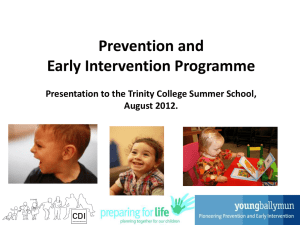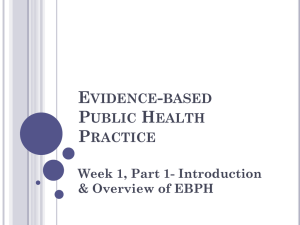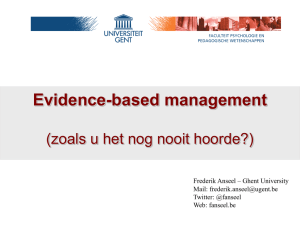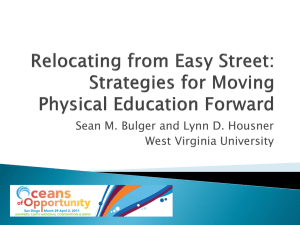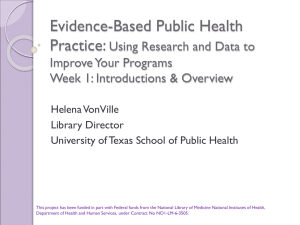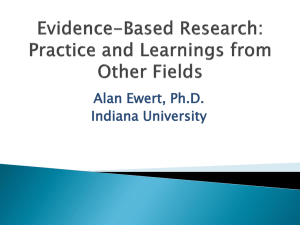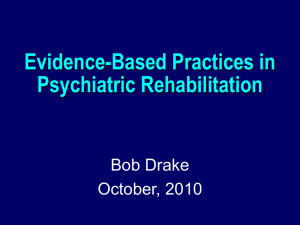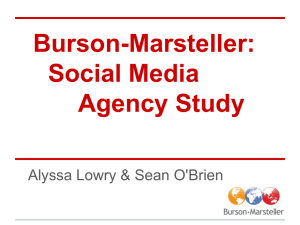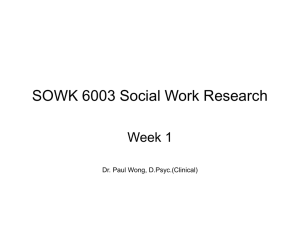supported employment - WV Behavioral Health Planning Council
advertisement
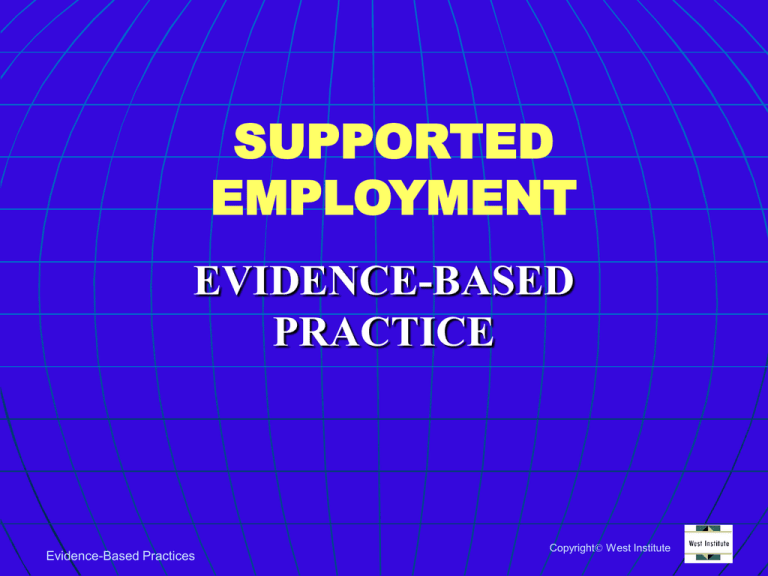
SUPPORTED EMPLOYMENT EVIDENCE-BASED PRACTICE Evidence-Based Practices Copyright West Institute Why Focus on Employment? Viewed by many as an essential part of recovery Most consumers want to work A typical role for adults in our society Cost-effective alternative to day treatment Evidence-Based Practices Copyright West Institute Positive Outcomes from Competitive Work Higher self-esteem Better control of psychiatric symptoms More satisfaction with finances and with leisure (Bond et al., 2001) Evidence-Based Practices Copyright West Institute Is Work Too Stressful? As compared to what? Joe Marrone, an employment trainer: “If you think work is stressful, try unemployment.” Stresses of work do not translate into higher rates of hospitalization Evidence-Based Practices Copyright West Institute Negative Effects of Unemployment in General Population Increased substance abuse Increased physical problems Increased psychiatric disorders Reduced self-esteem Loss of social contacts Alienation and apathy Evidence-Based Practices (Warr, 1987) Copyright West Institute Competitive Employment for People with Severe Mental Illness Say they want to work: 70% Are currently working: <15% Evidence-Based Practices Copyright West Institute Quotes from Consumers “I feel so much better about myself now that I have a job.” “Holding down my job is not always easy but it has helped my self esteem.” “When I go to work I don’t hear the voices.” “Now that I am working again I can buy my daughter presents.” Evidence-Based Practices Copyright West Institute Quotes from Family Members “I worried that if my son got a job he would get stressed. But just the opposite happened. He is doing so much better than before.” “I feel better that she tries working when she has the support of mental health.” “I was really glad that my son’s employment counselor asked me about work ideas. He landed a job that I suggested.” Evidence-Based Practices Copyright West Institute Quotes from Employers “Andre is as good as any worker that I have.” Automotive parts store manager. “I count on Juanita. If she is feeling stressed, she sits in the back room for awhile. That’s OK; she gets the job done.” Bakery supervisor. “The employment counselor helped me understand why Tony paces. It’s okay in the security business.” Security business owner. Evidence-Based Practices Copyright West Institute Evidence for Effectiveness % Gaining Competitive Employment: • 58% -- Supported Employment • 21% -- Traditional Voc Services, such as: Prevocational programs Sheltered workshops Transitional employment (Bond et al., 1997) Evidence-Based Practices Copyright West Institute Figure 2. Competitive Employment Rates in 6 RCTs of Supported Employment 90% 80% 70% 60% 50% Supported Employ ment 40% 30% 20% 10% 0% Bond 95 Chandler 97 Evidence-Based Practices Drake 96 Drake 99 Gervey 94 McFarlane 00 Copyright West Institute Cont rol Definition of Supported Employment Mainstream job in community Pays at least minimum wage Work setting includes people who are not disabled Service agency provides ongoing support Intended for people with most severe disabilities Evidence-Based Practices Copyright West Institute Evidence-Based Principles Eligibility is based on consumer choice Supported employment is integrated with treatment Competitive employment is the goal Job search starts soon after a consumer expresses interest in working Follow-along supports are continuous Consumer preferences are important Evidence-Based Practices Copyright West Institute Eligibility Is Based on Consumer Choice Consumers are not excluded because they are not “ready” or because of prior work history, hospitalization history, substance use, symptoms, or other characteristics. No one is excluded who wants to participate. Evidence-Based Practices Copyright West Institute Supported Employment Is Integrated with Mental Health Treatment Employment specialists coordinate plans with the treatment team, e.g., case manager, therapist, psychiatrist, etc. Evidence-Based Practices Copyright West Institute Competitive Employment Is the Goal The agency needs to devote sufficient resources to supported employment to permit full access to all consumers who seek competitive employment Consumers interested in employment are not steered into day treatment or sheltered work. Evidence-Based Practices Copyright West Institute Job Search Starts Soon After A Consumer Expresses Interest In Working Pre-employment assessment, training, and counseling are kept to a minimum. Evidence-Based Practices Copyright West Institute Follow-Along Supports Are Continuous Supported employment staff continue to stay in regular contact with consumer and (when appropriate) the employer without arbitrary time limits. Evidence-Based Practices Copyright West Institute Consumer Preferences Are Important Job finding is based on consumers’ preferences, strengths, and work experiences, not on a pool of jobs that are available. Evidence-Based Practices Copyright West Institute Key Factors in Implementation Build Consensus Maximize Financing Examine Agency Philosophy Identify Leadership Key on Organizational Structure Provide Ongoing Training Make Time Commitment Track Process and Outcomes Evidence-Based Practices Copyright West Institute Build Consensus Commitment of state mental health authority is not enough Better to involve all stakeholders - consumers, family members, providers, and local and state administrators Evidence-Based Practices Copyright West Institute Maximize Financing Determine how supported employment services can be funded Explore funding through mental health, vocational rehabilitation, and Medicaid Reallocate resources to supported employment when feasible Evidence-Based Practices Copyright West Institute What Does Supported Employment Cost? Some programs, $2,000-$4,000 per client per year (Clark, 1998). Figures vary according to severity of disability, local wages of employment specialists, and how much indirect costs and costs of clinical services are included Evidence-Based Practices Copyright West Institute Examine Agency Philosophy Determine if service agency’s philosophy, mission statement, and service paradigm are consistent with recovery-oriented, evidencebased approach to supported employment. Evidence-Based Practices Copyright West Institute Identify Leadership You need a champion! • Identify committed leader with sufficient authority to oversee and ensure implementation Leaders at all levels visibly show support for supported employment Center director buy-in is critical Evidence-Based Practices Copyright West Institute Leadership Roles Provide necessary resources Seek buy-in from consumers, families, and practitioners Give recognition to staff and consumer for successes Rapp’s finding – Critical role of supervisor in program success Evidence-Based Practices Copyright West Institute Organizational Structure Employment specialists • Each join one or two treatment teams. • Share office space with treatment team. • Communicate frequently with treatment team members. Team integrates supported employment, benefits counseling, case management, psychiatric services, and dual diagnosis treatment. Evidence-Based Practices Copyright West Institute Provide Ongoing Training Initial training for all team members, including medical staff Continuing access to expert consultation Ongoing supervision that is outcomes-oriented Evidence-Based Practices Copyright West Institute Make Time Commitment Typically, 6 - 12 months needed to develop skills, interest, and confidence for implementing evidence-based supported employment Evidence-Based Practices Copyright West Institute Track Implementation Process and Outcomes Track employment outcomes monthly Set goals: 40% rate of competitive employment is achievable Service agencies should use 15-item Supported Employment Fidelity Scale to measure implementation of evidencebased practice (Bond et al., 1997) Evidence-Based Practices Copyright West Institute Summary People with severe mental illness can work in competitive employment Programs following evidence-based principles of supported employment have better outcomes Programs must address financial and organizational barriers to be successful Evidence-Based Practices Copyright West Institute
